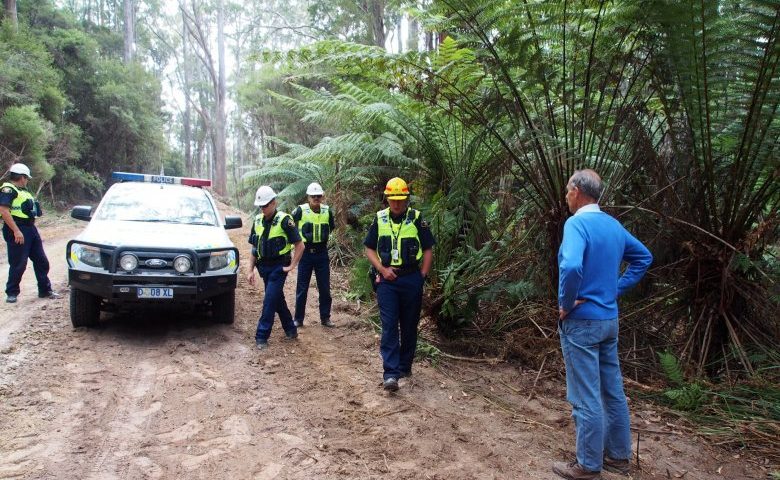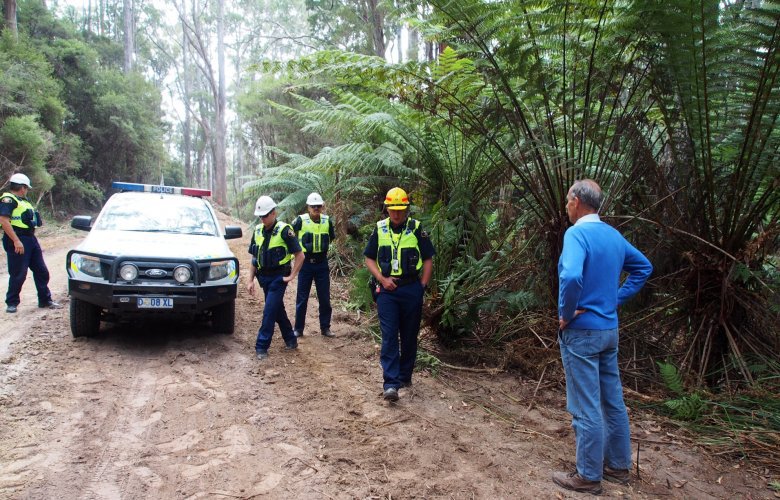Bob Brown’s arrest in Lapoinya under new anti-protestor laws

A High Court challenge to Tasmania’s controversial anti-protester laws follows their use to arrest conservationists in the Lapoinya forest.
Tree ferns grow in rare abundance in Tasmania’s Lapoinya forest. Their ornate fronds fan out metres above the ground, from slender trunks that have been growing for centuries.
The ferns’ Aboriginal name, Lapoinya, was adopted for the forest and for the district after European settlement more than a century ago. These ferns survived logging in the 1900s, when much of the rest of the forests – Lapoinya’s, Tasmania’s and Australia’s – were destroyed.
Maynes Creek, which flows through Lapoinya, is a vital nursery forAstacopsis gouldi, the world’s largest freshwater crayfish. Further down the river system, these giant crustaceans grow to 80 centimetres long and six kilograms in weight. Wildlife cameras have also captured endangered Tasmanian devils and spot-tailed quolls hunting in the forest at night.
However, in the past two months 49 hectares of the Lapoinya forest’s luxuriantly regrown ridges have been clear-felled – completely flattened. In the coming months, the logged areas will be incinerated to destroy any surviving native vegetation, so that the replacement plantation will not have to compete with resurgent native trees. This is where I was arrested in January, along with four others. Each of us faces a $10,000 fine or, should we put a foot back in the forest, four years in prison for protesting its destruction.
The biggest beneficiary of the timber carted out of Lapoinya is Malaysian logging corporation Ta Ann, which has a peeler plant on Tasmania’s north-west coast where timber is prepared for lamination. This multibillion-dollar juggernaut, having made its fortune out of the devastated rainforests of the Malaysian state of Sarawak, on Borneo, was given a $22 million incentive by the former Lennon Labor government to set up in Tasmania. More recently, Liberal senator Eric Abetz toured Ta Ann’s sites in Sarawak, encouraging the Indigenous people to be grateful for the logging.
Lapoinya is a small community, a scatter of farmhouses with an accommodation cottage and a small but remarkable French-inspired chateau. The Hoyt family grows some of the world’s finest garlic adjacent to the forest. Like other locals, they have been on a fast and rude learning curve since Liberal premier Will Hodgman determined to reinvigorate logging in the wake of his repudiation of the Tasmanian Forests Agreement. The agreement had been signed by loggers and environmentalists to bring an end to decades of “forest wars” in Tasmania.
Hodgman ditched it, joined Tony Abbott’s failed appeal to the World Heritage Committee to allow logging inside the Tasmanian Wilderness World Heritage Area, and brought the Lapoinya forest onto the chopping block for Ta Ann. An offer by the Lapoinyans to buy their forest was ignored.
In the uproar that followed the bulldozers invading Lapoinya in January, three board members and the chief executive of Forestry Tasmania resigned without explanation. Hodgman’s pugnacious pro-logging minister for forests, Paul Harriss, also resigned, saying he wanted to spend more time with his family.
The logging at Lapoinya torpedoed any hope Forestry Tasmania had of winning Forest Stewardship Council (FSC) certification, the internationally recognised green accreditation increasingly sought by global markets. FSC depends on respectful relationships with local communities.
Through all of this, the nation’s most powerful potential guardians of Australia’s forests and threatened species, Prime Minister Malcolm Turnbull and the federal minister for the environment, Greg Hunt, failed to lift a finger.
The right to protest under threat
At least we aren’t in Honduras, where assassination of environmentalists is rife. More than 100 environmentalists have been killed there since 2014. The murder of Berta Cáceres nearly three weeks ago – when gunmen broke into her house and killed her with a hail of bullets – came after she gained international applause for her campaign against a huge hydro-electric scheme involving European and Chinese corporations.
In Australia, the option of choice for setting back conservation is the strangling of environmental protest. As the resource-extraction industries come under fire for increasing encroachments on farmland and places of high natural or cultural heritage value, a key strategy is to have governments outlaw effective political protest.
Back in 1982, Tasmanian Liberal premier Robin Gray overturned centuries of common law, inherited from Britain, which protected citizens’ rights to enter crown land. Gray, who was also known as “The Whispering Bulldozer”, made it illegal to “lurk, loiter or secrete” in the riverside rainforests where the Hydro-Electric Commission was planning to build the Franklin Dam.
Gray’s legislation was flawed, and though more than 1300 protesters were arrested, the charges failed to stick. The dam was stopped after the High Court ruled that the Commonwealth’s foreign affairs powers, to uphold World Heritage protection of the Tasmanian wilderness, trumped the constitutional right of the state government to manage lands and dam rivers as it pleased.
The corporate sector was outraged. Bowing to that outrage, successive federal governments have handed power over World Heritage matters to the states, and Labor and Coalition governments have legislated to erode the right to protest.
Victoria’s Cain Labor government introduced targeted penalties against protesters trying to save native forests and wildlife, including the state’s endangered faunal emblem, the Leadbeater’s possum. These days, you can be summarily fined if a Victorian forest officer recognises you in a group photograph taken in a logging zone. The West Australian government has legislated draconian anti-protest laws to assist mining. In New South Wales, the government has adopted harsher anti-protest laws at the same time as it cuts penalties for illegal behaviour by mining and coal seam gas extraction companies.
The private sector has complemented these government moves. In 2005, the biggest logging company in Australia, Gunns Ltd, issued a SLAPP writ – that is, a Strategic Litigation Against Public Participation – against 20 opponents of its proposed Tamar Valley pulp mill. Those named included the Wilderness Society and me. Gunns’ action eventually failed, but it tied up the defendants for years.
In his book, Slapping on the Writs, Melbourne barrister Brian Walters cites an American definition of SLAPP as “a civil complaint or counterclaim for money damages filed against a private citizen or citizens’ groups who are targeted because of their communications to a government body or official or to voters in a community on an issue of public interest or concern”.
Such legal action – often involving suits for defamation – has been brought against environmentalists in every Australian state. Unlike the United States, where most jurisdictions now have anti-SLAPP laws, only the Australian Capital Territory has passed legislation introduced by the Greens to ensure people’s rights to take part in the political discourse without the threat of being entangled in the courts and the huge costs those actions entail.
New anti-protestor laws
But why should the mining or logging sector take action against citizens, including environmentalists, if it can get compliant governments to effectively silence public protests instead?
In Tasmania, Hodgman’s Workplaces (Protection from Protesters) Act passed with Labor’s support in 2014. It threatens peaceful protesters with initial $10,000 fines and with four years in jail for repeat on-site protests. Had it been enacted in 1982, the World Heritage Franklin River, now a prime attractant for Tasmania’s booming and job-rich tourism industry, would have been dammed because far fewer people would have joined the peaceful blockade. That blockade of the dam works succeeded because its size, colour and motion alerted the nation to the Franklin’s imminent peril. It changed votes and helped elect the anti-dam Hawke government in 1983.
Hodgman’s government assured the electorate that his legislation was aimed at “radical protesters” and not “mums and dads”. Its first test was Lapoinya.
The Lapoinyan community ran a spirited campaign to raise public awareness about the imminent logging of its forest. It letterboxed brochures, held film nights, wrote letters to politicians and newspapers and, when the minister for forests refused to go to Lapoinya, sent a delegation to Hobart to appeal to minister Harriss.
The community felt sure that the compelling case for saving its little patch of native forest, with those rare and endangered wildlife species, would win the day, but Hodgman sent in the chainsaws to keep Ta Ann happy.
However, the locals determined not to abandon their forest when the logging began. They faced up against the law. The first people arrested were a grandfather and a mother of two. The latter, Jessica Hoyt, now a neurosurgery nurse in Hobart, describes the forest as the “soul of our community”. She grew up next to the forest and was especially fond of the bridle trail that wound down to Maynes Creek.
After her arrest, I walked along the former bridle trail with three others and saw a bulldozer flattening the forest, including its ferns. This bulldozer reversed back down the trail and out of sight. The police arrived and two of us were arrested and charged under Hodgman’s new laws, which define a protester as a person engaged in activity “for the purposes of promoting awareness of or support for an opinion, or belief, in respect of a political, environmental, social, cultural or economic issue”. Our two companions, though they left the forest when requested, have received infringement notices and fines.
Jessica Hoyt and I attended the Hobart Magistrates Court a week ago. The cases were adjourned until June 7.
High Court challenge
There is an implied provision in the Commonwealth constitution protecting freedom of communication on government and political matters. Through Hobart solicitor Roland Browne, I have engaged Melbourne counsel Ron Merkel, QC, assisted by Frances Gordon. I have issued a writ challenging the Tasmanian legislation in the High Court because it “impermissibly burdens the implied freedom of communication on government and political matters contrary to the Commonwealth constitution”.
Hodgman’s minister for the environment, Matthew Groom, is confident his legislation will prevail.
This is not Honduras but here are environment ministers Groom and Hunt backing the arrest and punishment of Australians who make a modest stand for threatened species that they, the ministers, should be protecting.
In an age of the accelerating and irreversible destruction of our Earth’s biosphere, the untoward and often unseen influence of its exploiters is eroding Australia’s time-honoured rights to peaceful protest.
It was inevitable that somewhere, some time, some citizens would face the repressive Tasmanian laws. That stand has now been made among the stately ferns of Lapoinya and will move to the High Court of Australia where the consequences are enormous for every environmental, social, cultural and Indigenous issue in Australia’s future.



